गोभी फसलों के कीट पतंगों का पर्यावरण-अनुकूल प्रबंधन
Cole crops are cultivated extensively in tropical and temperate regions of the world including India. The chief constraint in the production of cole crops is the damage caused by pest complex right from germination till harvest. In India, a total of 37 insect pests have been recorded on cole crops (Lal, 1975). The extent of damage due to these pests in India is known from 7 to 90 per cent with consequent reduction in yield from 20 to 80 per cent (Prasad, 1963).
Since cole crops are highly remunerative, intensive plant protection measures involving a number of insecticides are common. In spite of large scale and indiscriminate applications of insecticides, the pests have been found to occur in severe form in all cole crop growing areas.
This has resulted in several problems viz., pesticide resistance, resurgence, residue problems, death of natural enemies, environmental pollution etc(Vastrad et al., 2004). These undesirable effects of synthetic chemicalshave encouraged the development of non-chemical package or a programme with least pesticide usage to manage the pests.
In recent years, there is a lot of awareness and preference for organically produced foodstuff in the country. Therefore, ecofriendly pest management has gained worldwide attention. This technology is not only effective against crop pests but also safer to beneficial insects and environment (Patel et al., 2003).
Pests of cole crops and their damage symptoms:
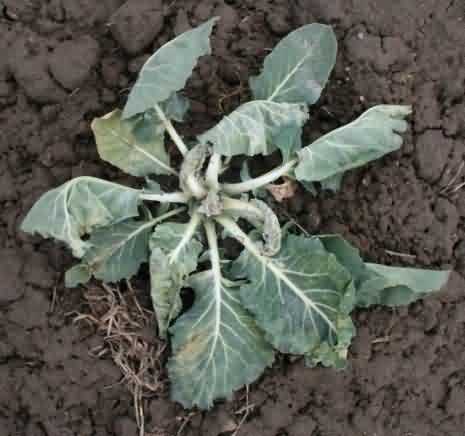 Aphids:
Aphids:
Aphids, also known as plant lice, which are small insects, suck the sap from leaves, stems and apical portion by inserting their stylets into the host plants. Feeding by aphids cause discoloration, distortion and mosaic that result in stunted plant growth (Fig.1). They also secrete honeydew on which black sooty mold develop under high atmospheric relative humidity, which interferes with photosynthetic activity. Due to their quick multiplication rate they could complete one generation in 7-10 days and by giving birth to six to ten young ones per day with 50-100 in total life span. Enormous populations can thus build up in a relatively short period.
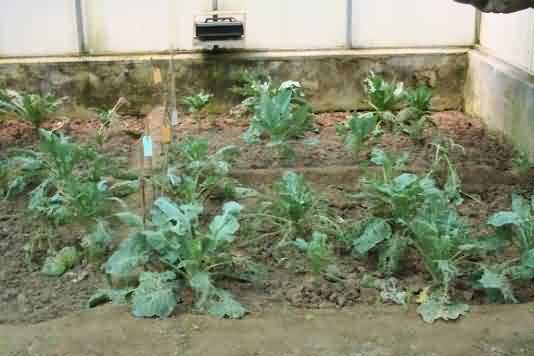 Diamond backmoth: Plutella xylostella (L.)
Diamond backmoth: Plutella xylostella (L.)
DBM is a cosmopolitan major defoliating caterpillar that hampers the successful cultivation of cole crops. The young caterpillars look green-creamish in colour and scrape the green tissues that turn to white patches in later stage. Whereas, grown up caterpillar makes holes in the leaves and cause defoliation resulting in huge crop loss (Fig. 2).
Cabbage butterfly Pieris brassicae L.
It is the most serious defoliator of cole crops in nursery as well as in main crop. Adult lays yellowish eggs on the leaves in clusters (Fig. 3a). The young neonates are greenish to velvety, with yellowish lateral stripes and black spots and white hairs. Grown up larvae appear in gregarious form on plants and defoliates it (Fig. 3b).
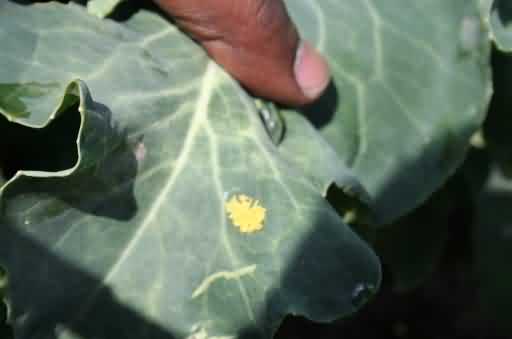
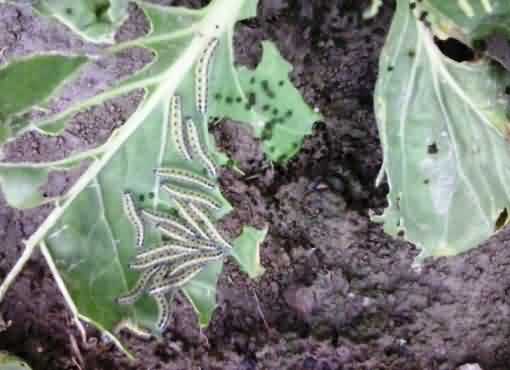
Fig. 3a Fig. 3b
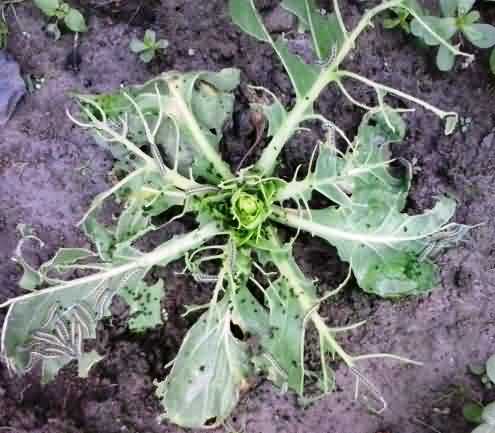 Cabbage semilooper Trichoplusia ni Hubner
Cabbage semilooper Trichoplusia ni Hubner
Young caterpillars feed primarily on leaves and cause irregular holes. Whereas, older one feed on the tissue between the veins thereby skeletonising the leaves (leaving only the midribs and veins) or giving them a ragged appearance. Plants thus appeared severely defoliated and stunted, producing no heads/curds.
Tobacco caterpillar, Spodoptera litura (Fabricius)
Larvae, slender green with light wavy lines, appear in cluster at early stage and individually on later stage on plants. Defoliation is the major damage caused by Spodoptera thatresulted in considerable loss to the crops.
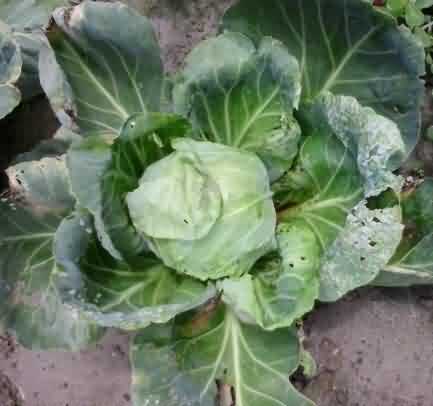 Leaf Webber: Crocidolomia binotalis
Leaf Webber: Crocidolomia binotalis
Very serious pest at early stages of the plants as the gregarious larvae attack the tender plants (Fig.4) and at later stage webs the leaf and feed by remaining inside. The apical portion will become stunted and no formation of head/curd.
Head borer: Hellula undalis Fabricius
The borers attack the young developing heads of cabbage and curd of cauliflower. It bores deep inside the growing point/head and feed by remaining within (Fig.5). Faecal pellets of the pest give an indication of its presence. Under severe incidence of the pest, huge crop loss can be expected.
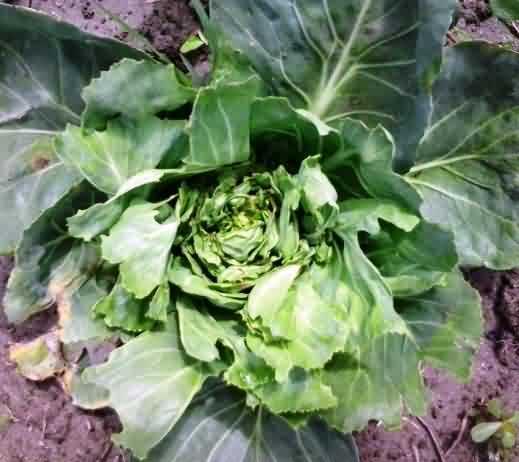
Fig. 5
Eco-friendly Management of Insects and pests of Cole crop:
Before Planting
- Deep ploughing in the month of summer to expose immature stages of insect pest like tobacco caterpillar
- Hand picking and destruction of P. brassicae eggs and larvae in nursery as well as main crop to reduce the pest multiplication
- Grow African bold seeded mustard as trap crop at 22:2 ratio (Cabbage: Mustard) to attract DBM for oviposition at least 10 days ahead of planting of main crop
After Planting
- Regular Monitoring of the plants randomly for the presence of pests on both the leaf surface as well as between the leaves
- Hand picking and destruction of leaf webber and S. litura egg masses and early instar larvae to reduce further multiplication of pests in the field
- Hook out the head borer and destroy mechanically
- Spray neem seed powder extract 4% @ every 10 days interval starting from 30 days after planting (DAT) and alternate spray with Neem cake (5%) – petrol extract (0.1%) to keep the pest in check.
- Spray neem soap 1% to manage the sucking pests at 10 days interval from 30 to 90 DAT.
- Spray Lipel 8 SP (Bt var. kurstaki) @ 0.2% at 15 days interval after 22-25 DAT to manage DBM
- Spray Cartap hydrochloride 0.5% at 10, 20 and 30 DAS (nursery) and primordial stage against DBM.
- Encourage bio-control agents; Cotesia plutellae (Plains),Diadegma semiclausm (hills), Trichogrammatoidea bactrae, Diaeretiella rapae (M'intosh), Cotesia glomeratus and cocinellids, syrphid flies larvae and spiders by following above management tactics.
References:
- Mallapur, C. P. (1988). Studies on seasonal incidence and chemical control of cabbage pests. M. Sc. (Agri) Thesis, University of Agricultural Sciences, Dharwad. p.114.
- Lal, O. P. (1975). A Compendium of insect pest of vegetables in India. Bulletin of Entomology, 16: 31-56.
- Patel, P. S., Shukla, N. P. and Patel, G. M. (2003). Enhancing insecticidal properties of cow urine against sucking pests of cotton. In : Proceedings of the National Symposium on Fronterier Areas of Entomological Research, 5-7 November, 2003, pp. 385-386.
- Prasad, S. K. (1963). Quantitative estimation of damage to crucifers caused by cabbage worm. Cabbage looper, diamondback moth and aphids. Indian Journal of Entomology, 25 : 242-261.
- Vastrad, A. S., Lingappa, S. and Basavana Goud, K .(2004). Ovicides for managing resistant populations of Diamondback Moth, Plutella xylostella L. Resistant Pest Management Newsletter, 14 : 16-17.
Authors:
N.R. Prasannakumar, Chander Parkash and G.M. Sandeep Kumar
Indian Agricultural Research Institute,
Regional Station, Katrain (Kullu Valley), Himachal Pradesh-175 129
Email:
